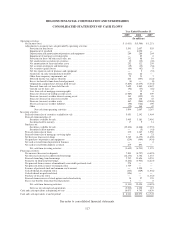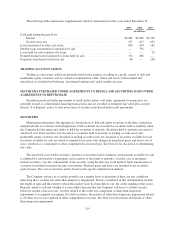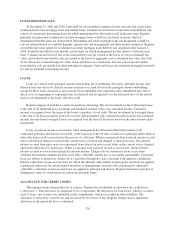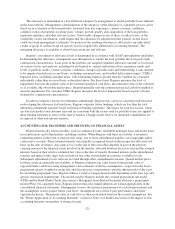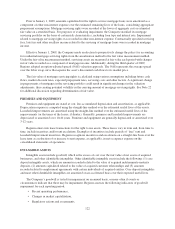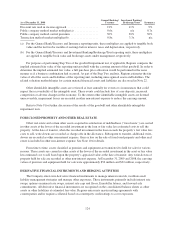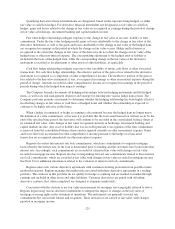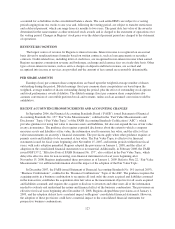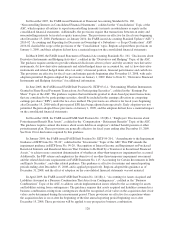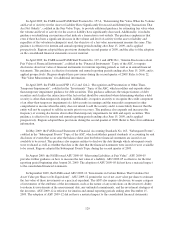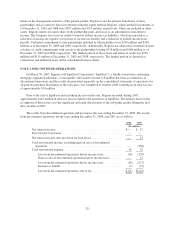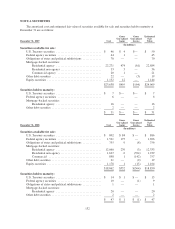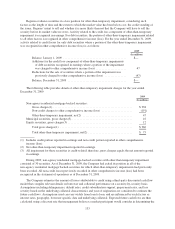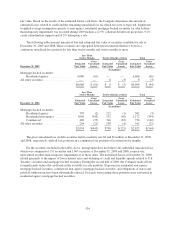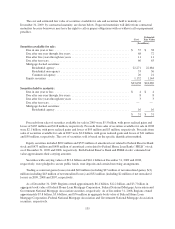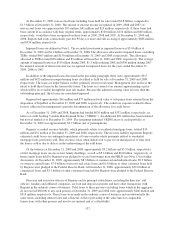Regions Bank 2009 Annual Report Download - page 141
Download and view the complete annual report
Please find page 141 of the 2009 Regions Bank annual report below. You can navigate through the pages in the report by either clicking on the pages listed below, or by using the keyword search tool below to find specific information within the annual report.accounted for as liabilities in the consolidated balance sheets. The cash settled RSUs are subject to a vesting
period ranging from two weeks to one year and, following the vesting period, are subject to transfer restrictions
and a delayed payment, which can range from six months to two years. The grant date fair value of the award is
determined in the same manner as other restricted stock awards and is charged to the statement of operations over
the vesting period. Changes in Regions’ stock price over the delayed payment period are charged to the statement
of operations.
REVENUE RECOGNITION
The largest source of revenue for Regions is interest income. Interest income is recognized on an accrual
basis driven by nondiscretionary formulas based on written contracts, such as loan agreements or securities
contracts. Credit-related fees, including letter of credit fees, are recognized in non-interest income when earned.
Regions recognizes commission revenue and brokerage, exchange and clearance fees on a trade-date basis. Other
types of non-interest revenues, such as service charges on deposits and trust revenues, are accrued and
recognized into income as services are provided and the amount of fees earned are reasonably determinable.
PER SHARE AMOUNTS
Earnings (loss) per common share computations are based upon the weighted-average number of shares
outstanding during the period. Diluted earnings (loss) per common share computations are based upon the
weighted- average number of shares outstanding during the period, plus the effect of outstanding stock options
and stock performance awards if dilutive. The diluted earnings (loss) per common share computation also
assumes conversion of convertible preferred stock and warrants, unless such an assumed conversion would be
antidilutive.
RECENT ACCOUNTING PRONOUNCEMENTS AND ACCOUNTING CHANGES
In September 2006, the Financial Accounting Standards Board (“FASB”) issued Statement of Financial
Accounting Standards No. 157 “Fair Value Measurements”, codified in the “Fair Value Measurements and
Disclosures” Topic (“Fair Value Topic”) of the FASB Accounting Standards Codification (“ASC”), which
provides guidance for using fair value to measure assets and liabilities, but does not expand the use of fair value
in any circumstance. The guidance also requires expanded disclosures about the extent to which a company
measures assets and liabilities at fair value, the information used to measure fair value, and the effect of fair
value measurements on an entity’s financial statements. The provisions apply when other guidance requires or
permits assets and liabilities to be measured at fair value. The Fair Value Topic is effective for financial
statements issued for fiscal years beginning after November 15, 2007, and interim periods within those fiscal
years, with early adoption permitted. Regions adopted the provisions on January 1, 2008, and the effect of
adoption on the consolidated financial statements was not material. Additionally, in February 2008, the FASB
issued FSP 157-2, “Effective Date of FASB Statement No. 157”, also codified in the Fair Value Topic, which
delays the effective date for non-recurring, non-financial instruments to fiscal years beginning after
November 15, 2008. Regions implemented these provisions as of January 1, 2009. Refer to Note 22, “Fair Value
Measurements” for additional information about the impact of the adoption of the Fair Value Topic.
In December 2007, the FASB issued Statement of Financial Accounting Standards No. 141 (revised 2007),
“Business Combinations”, codified in the “Business Combinations” Topic of the ASC. The guidance requires the
acquiring entity in a business combination to recognize all (and only) the assets acquired and liabilities assumed
in the transaction; establishes the acquisition-date fair value as the measurement objective for all assets acquired
and liabilities assumed; and requires the acquirer to disclose to investors and other users all of the information
needed to evaluate and understand the nature and financial effect of the business combination. The provisions are
effective for fiscal years beginning after December 15, 2008. Regions adopted these provisions as of January 1,
2009, and the adoption did not have a material impact on Regions’ consolidated financial statements. However,
the adoption of these provisions could have a material impact to the consolidated financial statements for
prospective business combinations.
127


